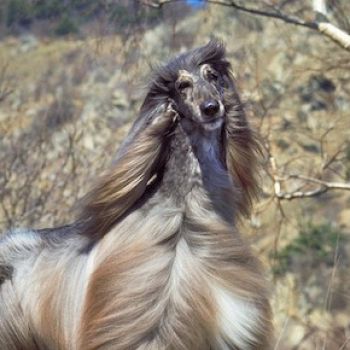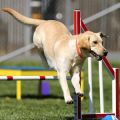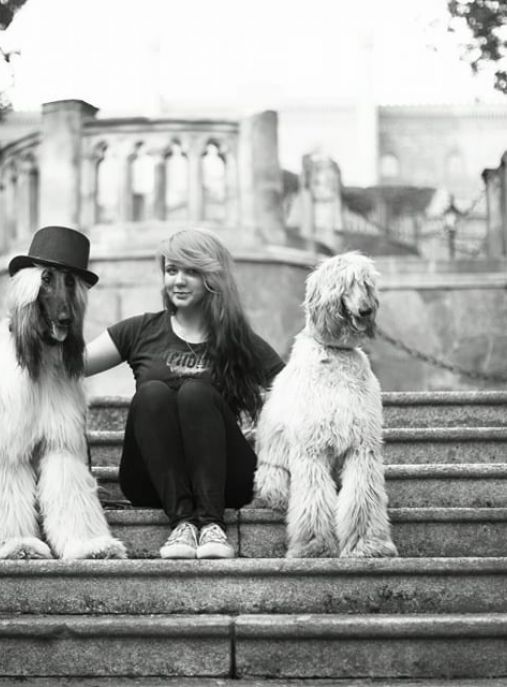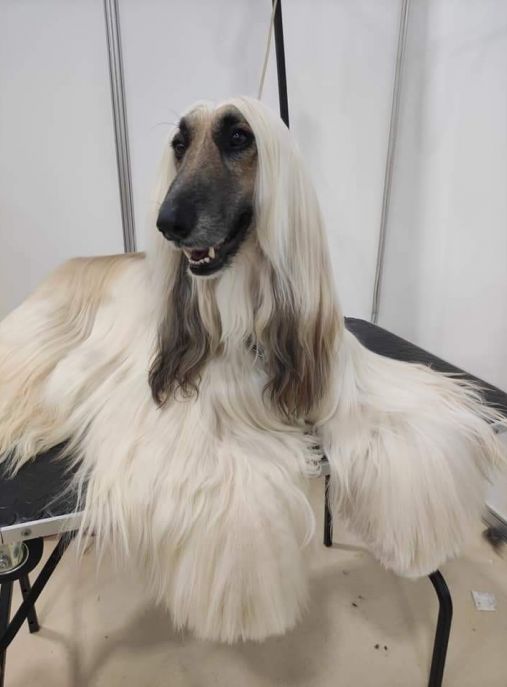The Afghan Hound is a majestic and elegant breed that captures the hearts of dog enthusiasts worldwide. With its long, flowing coat and regal appearance, this breed is often referred to as the "King of Dogs." Originating from Afghanistan, this ancient breed has a rich history and a unique set of characteristics that make it truly one-of-a-kind.
The Afghan Hound is believed to have existed for thousands of years, with evidence of its existence dating back to ancient Egyptian times. These dogs were highly valued for their hunting skills, particularly in the rugged terrains of Afghanistan. They were primarily used for hunting large game, such as deer, wolves, and even leopards.
According to the FCI (Fédération Cynologique Internationale) typology, the Afghan Hound belongs to Group 10, which includes the Sighthounds. These dogs are known for their exceptional speed and keen eyesight, which allows them to spot prey from a distance and chase it down with remarkable agility.
In terms of appearance, the Afghan Hound is a large and slender breed. Males typically stand between 27 to 29 inches (68 to 74 cm) at the shoulder, while females are slightly smaller, ranging from 25 to 27 inches (63 to 69 cm). Their weight can vary between 50 to 60 pounds (23 to 27 kg) for males and 40 to 50 pounds (18 to 23 kg) for females.
One of the most distinctive features of the Afghan Hound is its luxurious coat. It is long, silky, and flowing, requiring regular grooming to maintain its beauty. The coat comes in a variety of colors, including black, cream, red, and various shades of gray. The Afghan Hound's coat is not only aesthetically pleasing but also serves as protection against the harsh Afghan climate.
In terms of temperament, the Afghan Hound is known for its independent and aloof nature. While they are generally affectionate with their families, they can be reserved and even standoffish with strangers. This breed requires patient and consistent training, as they can be quite stubborn at times. Despite their independent streak, Afghan Hounds are loyal and devoted to their loved ones.
The Afghan Hound has a relatively long lifespan compared to other large breeds, with an average life expectancy of 12 to 14 years. However, they are prone to certain health issues, including hip dysplasia, eye problems, and thyroid disorders. Regular veterinary check-ups and a balanced diet are essential to ensure their overall well-being.
Due to their unique appearance and regal demeanor, Afghan Hounds are often seen in the show ring. Their graceful movement and striking presence make them a favorite among judges and spectators alike. However, it's important to note that their show coat requires extensive grooming and maintenance, which can be time-consuming.
While Afghan Hounds excel in the show ring, they are also cherished as beloved family pets. Despite their elegant appearance, they are known to be playful and enjoy the company of their human companions. However, their high prey drive and independent nature mean that they may not be suitable for households with small pets or young children.
In conclusion, the Afghan Hound is a breed that exudes beauty, grace, and a touch of mystery. With its ancient origins and unique set of characteristics, it continues to captivate dog lovers around the world. Whether as a show dog or a cherished family pet, the Afghan Hound leaves an indelible mark on the hearts of those fortunate enough to share their lives with this extraordinary breed.

The Afghan Hound, with its regal appearance and graceful demeanor, is a breed known for its unique character and charm. These dogs possess a captivating personality that sets them apart from other breeds. From their independent nature to their gentle yet aloof behavior, Afghan Hounds are a breed that requires a special understanding and approach when it comes to raising and training them.
One of the defining characteristics of Afghan Hounds is their independent nature. They are known to be quite self-reliant and can sometimes exhibit a stubborn streak. This independence can make training a challenge, as they may not always be eager to please their owners. Patience and consistency are key when it comes to training an Afghan Hound, as they respond best to positive reinforcement techniques and rewards.
Despite their independent nature, Afghan Hounds are also incredibly loyal and affectionate towards their families. They form strong bonds with their owners and thrive on human companionship. However, they can be reserved and aloof with strangers, often maintaining a dignified and somewhat distant demeanor. Early socialization is crucial to ensure they grow up to be well-rounded dogs who are comfortable in various situations and around different people.
Afghan Hounds have a natural instinct to chase and hunt, as they were originally bred for hunting in the rugged terrains of Afghanistan. This instinct can make them prone to chasing small animals or even running off if they catch an interesting scent. Therefore, it is important to provide them with a secure and fenced-in area to prevent any potential escapes. Regular exercise, such as long walks or runs, is also essential to keep them physically and mentally stimulated.
Grooming an Afghan Hound is a task that requires dedication and commitment. Their long, flowing coat is one of their most distinctive features, but it also requires regular maintenance to keep it in optimal condition. Daily brushing is necessary to prevent matting and tangling, and occasional bathing is required to keep their coat clean and healthy. Additionally, their ears should be checked regularly to prevent any infections.
When it comes to training, Afghan Hounds can be a bit of a challenge. They have an independent streak and may not always respond to traditional training methods. Positive reinforcement techniques, such as using treats and praise, work best with this breed. Consistency, patience, and a gentle approach are essential to building a strong bond with an Afghan Hound and achieving successful training outcomes.
In conclusion, Afghan Hounds are a breed with a unique character that requires a special approach to raising and training. Their independent nature, combined with their loyalty and aloofness, makes them a fascinating and captivating breed. With patience, consistency, and positive reinforcement, Afghan Hounds can become well-behaved and loving companions, showcasing their regal charm and grace in every aspect of their lives.
The Afghan Hound is a majestic and elegant breed known for its long, flowing coat and regal appearance. Caring for an Afghan Hound requires a dedicated and meticulous approach to ensure their health, happiness, and overall well-being. Here are some essential tips on how to properly care for Afghan Hound dogs, including what to do and what not to do.
Grooming is of utmost importance when it comes to Afghan Hounds. Their luxurious coat requires regular maintenance to prevent matting and keep it in pristine condition. Daily brushing is recommended to remove tangles and prevent the hair from becoming matted. Use a slicker brush or a wide-toothed comb to gently work through the hair, starting from the ends and working your way up to the roots. Be patient and gentle to avoid causing any discomfort to your dog.
Bathing an Afghan Hound should be done approximately once every three weeks. Use a mild dog shampoo and conditioner specifically formulated for long-haired breeds. Thoroughly rinse out all the products to prevent any residue from irritating the skin. After bathing, carefully dry the coat with a towel and then use a blow dryer on a low heat setting to avoid overheating. Regularly trimming the hair around the paws and ears will help prevent dirt and debris from accumulating.
While grooming is essential, it's equally important to provide proper nutrition to maintain your Afghan Hound's health. Feed them a high-quality dog food that is appropriate for their age, size, and activity level. Consult with your veterinarian to determine the right amount of food and feeding schedule for your dog. Afghan Hounds are prone to bloat, so it's advisable to divide their meals into smaller portions throughout the day and avoid vigorous exercise immediately after eating.
Exercise is crucial for Afghan Hounds to keep them physically and mentally stimulated. Despite their elegant appearance, they are active dogs that require regular exercise to prevent boredom and destructive behavior. Daily walks, playtime, and off-leash activities in a securely fenced area are recommended. However, avoid excessive running or jumping on hard surfaces, as this breed is prone to joint issues.
Afghan Hounds are sensitive dogs that thrive on love, attention, and positive reinforcement. Provide them with a calm and structured environment, as they can be easily stressed by loud noises or chaotic surroundings. Socialize your Afghan Hound from an early age to ensure they are comfortable around people, other animals, and different environments. Training should be consistent, firm, and reward-based to establish boundaries and prevent any stubborn behavior.
When it comes to what not to do, avoid leaving your Afghan Hound alone for extended periods as they are prone to separation anxiety. They are also not well-suited for outdoor living and should be kept indoors with access to a securely fenced yard. Harsh training methods or physical punishment should never be used, as it can damage their sensitive nature and trust in their owner.
Regular veterinary check-ups are essential to monitor your Afghan Hound's health and address any potential issues promptly. Vaccinations, parasite prevention, dental care, and routine examinations should be part of their healthcare regimen.
In conclusion, caring for an Afghan Hound requires commitment, patience, and attention to detail. By following these tips and providing the necessary care, you can ensure that your Afghan Hound lives a happy, healthy, and fulfilling life.
The Afghan Hound, known for its regal appearance and graceful demeanor, is a breed that possesses a wide range of coat colors. However, one of the most common and iconic colors seen in Afghan Hound dogs is a stunning shade of sandy or golden tan. This color, often referred to as "cream," "fawn," or "pale gold," is a defining characteristic of this majestic breed.
The coat of an Afghan Hound is long, silky, and flowing, adding to its overall elegance. The cream-colored coat is typically uniform throughout the body, with variations in shades and intensity. The color can range from a light, almost white cream to a deeper, richer golden hue. The coat's texture and length contribute to the way the color is perceived, as it catches the light and creates a beautiful shimmering effect.
The cream color of Afghan Hound dogs is often accompanied by a darker mask on the face, which adds depth and contrast to their appearance. This mask can vary in intensity, ranging from a subtle shading around the eyes and muzzle to a more pronounced and defined coloration. The mask may also extend to the ears, further enhancing the dog's striking facial features.
In addition to the cream coat, Afghan Hounds may have slight variations in color on certain parts of their body. It is not uncommon to see darker shading on the ears, tail, or along the back. These darker areas can range from a deeper cream to a light tan or even a sandy brown. These subtle variations in color add dimension and character to the overall appearance of the Afghan Hound.
The cream color of Afghan Hound dogs is not only visually appealing but also serves a practical purpose. This coat color helps them blend seamlessly with their natural surroundings in their native Afghanistan, where they were originally bred for hunting in the rugged terrains. The sandy and golden tones of their coat allow them to camouflage effectively, making them excellent hunters and trackers.
It is worth noting that while cream is a common and highly sought-after color in Afghan Hound dogs, the breed also comes in a variety of other colors. These include black, brindle, silver, and various shades of red. Each color variation brings its own unique charm and allure to this magnificent breed.
In conclusion, the common color of Afghan Hound dogs is a breathtaking shade of cream. This color, ranging from a light, almost white cream to a deeper golden hue, is complemented by a darker mask on the face, adding depth and contrast. The Afghan Hound's cream coat, along with its long and flowing texture, contributes to its regal appearance and makes it a truly captivating breed.
The Afghan Hound is a majestic and elegant breed known for its long, silky coat and regal appearance. While they are generally a healthy breed, like any other dog, Afghan Hounds are prone to certain health issues that owners should be aware of. Proper care and regular veterinary check-ups are essential to ensure the well-being of these beautiful dogs.
One of the most common health concerns in Afghan Hounds is hip dysplasia. This condition occurs when the hip joint doesn't develop properly, leading to discomfort, lameness, and even arthritis. Regular exercise, a balanced diet, and maintaining a healthy weight can help reduce the risk of hip dysplasia. Additionally, responsible breeders should perform hip evaluations on their breeding dogs to minimize the chances of passing on this condition.
Another health issue that Afghan Hounds may face is progressive retinal atrophy (PRA). PRA is a degenerative eye disease that gradually leads to vision loss and, in severe cases, blindness. Regular eye examinations by a veterinary ophthalmologist can help detect PRA early on, allowing for appropriate management and care.
Afghan Hounds are also prone to developing skin problems. Their long, flowing coat requires regular grooming to prevent matting and tangling, which can lead to skin irritation. Regular brushing, bathing with a gentle shampoo, and keeping the coat clean and well-maintained can help prevent skin issues. Additionally, it's important to protect Afghan Hounds from extreme weather conditions, as their thin coat offers minimal insulation.
Like many deep-chested breeds, Afghan Hounds are at risk of developing bloat, also known as gastric dilatation-volvulus (GDV). Bloat is a life-threatening condition that occurs when the stomach fills with gas and twists on itself. Symptoms include restlessness, unproductive vomiting, and a distended abdomen. Immediate veterinary attention is crucial if bloat is suspected. To minimize the risk of bloat, it's recommended to feed Afghan Hounds smaller, frequent meals and avoid vigorous exercise immediately before or after meals.
Regular veterinary check-ups are essential for Afghan Hounds to ensure their overall health. Vaccinations, parasite prevention, and dental care should be part of their routine healthcare. Afghan Hounds should also be provided with a balanced diet that meets their nutritional needs, and their weight should be monitored to prevent obesity, which can exacerbate certain health issues.
Exercise is important for Afghan Hounds, but it should be moderate and not excessive. They enjoy daily walks and playtime, but high-impact activities should be avoided to protect their joints. Mental stimulation is equally important, as Afghan Hounds are intelligent dogs that thrive on mental challenges and social interaction.
In conclusion, Afghan Hounds are generally healthy dogs, but they are prone to certain health issues that owners should be aware of. Regular veterinary care, proper grooming, a balanced diet, and appropriate exercise are key to maintaining their overall health and well-being. With proper care and attention, Afghan Hounds can live long, happy lives as cherished companions.
The Afghan Hound is a majestic and elegant breed known for its long, flowing coat and regal appearance. To maintain their health and vitality, it is crucial to provide them with a well-balanced and nutritious diet. Proper nutrition plays a vital role in the overall well-being of Afghan Hound dogs, ensuring they have the energy, strength, and shiny coat they are famous for.
When it comes to feeding Afghan Hounds, it is essential to choose high-quality dog food that meets their specific nutritional needs. Look for a premium dog food brand that lists real meat as the primary ingredient, such as chicken, beef, or lamb. Avoid foods that contain fillers, by-products, or artificial additives, as these can be detrimental to their health.
Protein is a crucial component of an Afghan Hound's diet, as it helps support their lean muscle mass. Aim for a dog food that contains at least 25-30% protein. Additionally, the food should have a moderate fat content of around 15-20% to provide them with the necessary energy.
Afghan Hounds have a unique coat that requires special attention. Their long, silky hair needs to be nourished from the inside out. Including essential fatty acids in their diet, such as omega-3 and omega-6, can help promote a healthy coat and skin. Look for dog foods that contain fish oil or flaxseed, as these are excellent sources of these fatty acids.
To maintain a healthy weight, Afghan Hounds should be fed according to their age, size, and activity level. It is recommended to divide their daily food intake into two meals to prevent overeating and aid digestion. Avoid free-feeding, as it can lead to obesity, which can put strain on their joints and overall health.
In addition to a balanced diet, Afghan Hounds can benefit from occasional supplementation. Consult with your veterinarian to determine if your dog requires any specific supplements, such as joint support or multivitamins. However, it is important not to over-supplement, as excessive amounts of certain vitamins and minerals can be harmful.
While Afghan Hounds have specific dietary requirements, there are also certain foods that should be avoided. Some human foods can be toxic to dogs, including chocolate, grapes, raisins, onions, garlic, and caffeine. These can cause severe health issues, including kidney damage, anemia, and even death. It is crucial to keep these foods out of reach and educate family members and visitors about the dangers of feeding them to Afghan Hounds.
Lastly, always ensure your Afghan Hound has access to fresh, clean water at all times. Hydration is essential for their overall health and well-being.
In conclusion, providing a well-balanced and nutritious diet is crucial for the health and vitality of Afghan Hound dogs. Choose high-quality dog food that contains real meat, adequate protein, and moderate fat content. Include essential fatty acids to promote a healthy coat and skin. Feed them according to their age, size, and activity level, and avoid overfeeding. Consult with your veterinarian regarding any necessary supplements. Avoid toxic foods and always provide fresh water. By following these guidelines, you can ensure your Afghan Hound thrives and enjoys a long, healthy life.








